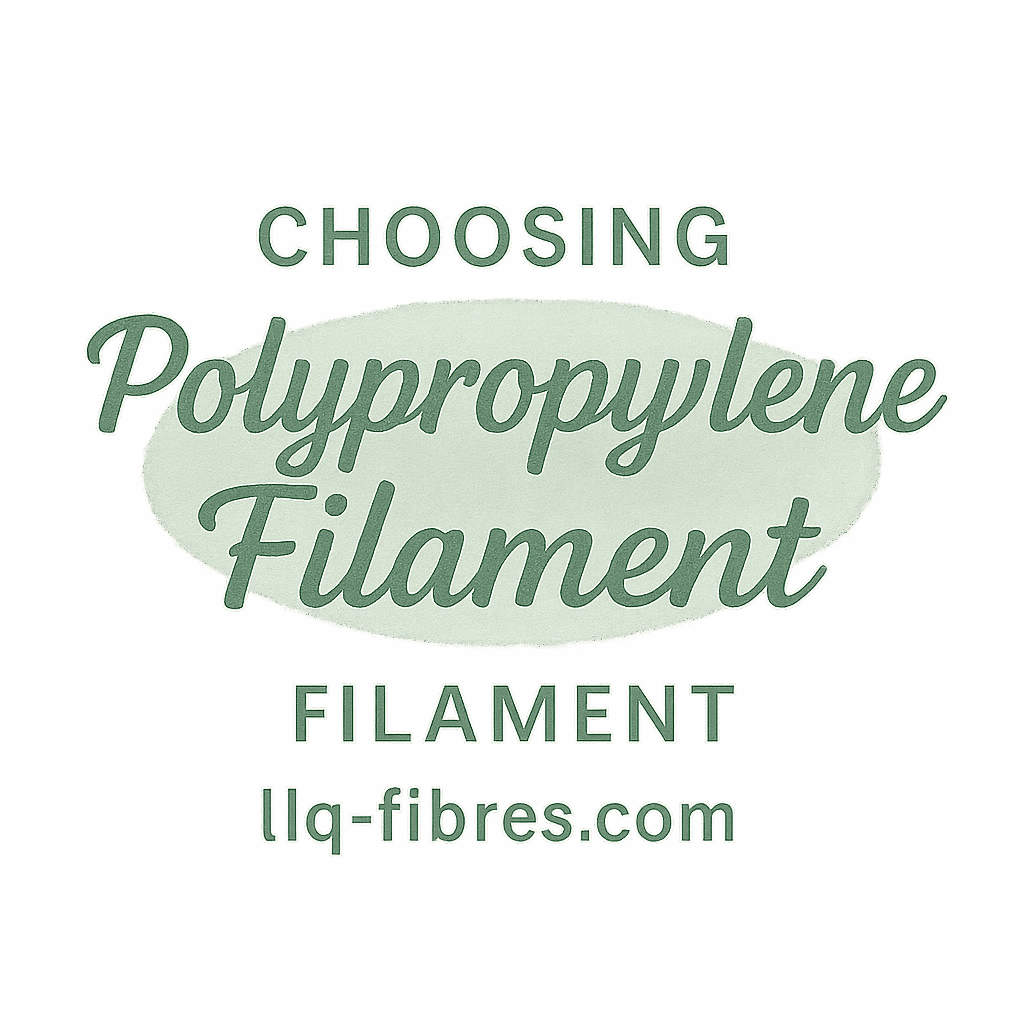When it comes to choosing the right rope material for various applications, there are several options to consider. However, polypropylene filament consistently stands out as one of the most versatile, cost-effective, and durable choices. In this article, we’ll explore six key reasons why polypropylene filament outperforms other rope materials in a variety of industries.
Introduction to Polypropylene Filament
What is Polypropylene Filament?
Polypropylene filament is a synthetic material that is commonly used to produce ropes, fibers, and other industrial materials. Known for its strength and resilience, polypropylene is widely used across industries ranging from agriculture to maritime applications. Unlike traditional rope materials, polypropylene filament offers a unique combination of benefits that make it an excellent choice for numerous tasks.
Why Rope Material Matters
The Importance of Choosing the Right Rope Material
Selecting the right rope material is crucial for ensuring success in any project. Whether you are using ropes for agricultural tasks, maritime operations, or construction, the material you choose will determine the rope’s strength, durability, and longevity. Ropes made from different materials come with varying characteristics, so understanding these differences is essential. Polypropylene filament strikes a perfect balance between strength, lightweight design, and affordability, making it a top choice for many applications.

Durability Comparison
Polypropylene Filament vs. Other Materials
When it comes to durability, polypropylene filament is a tough competitor. Let’s take a closer look at how it compares to other rope materials, such as nylon, polyester, and natural fibers.
Resistance to Wear and Tear
Polypropylene filament resists wear and tear better than many other materials. Unlike natural fibers that degrade quickly when exposed to moisture, polypropylene maintains its strength and shape for a much longer period. This makes it ideal for outdoor applications, especially in environments where ropes face rough conditions and constant use.
Resistance to UV and Weathering
A standout feature of polypropylene filament is its ability to withstand UV rays and harsh weather. Other materials like cotton or hemp tend to degrade when exposed to the sun and elements. However, polypropylene is resistant to UV radiation, ensuring it doesn’t lose its strength and integrity over time.
Weight and Floatation
How Polypropylene Beats Other Materials in Weight and Floatation
One of the major benefits of polypropylene filament is its lightweight nature, which is crucial in many applications. Let’s see how it compares to other materials in terms of weight and floatation.
Lightweight Characteristics
Polypropylene ropes are much lighter than materials like nylon or polyester. This makes them easier to handle, transport, and work with, especially in large quantities. Despite its lightweight nature, polypropylene doesn’t compromise on strength and can handle heavy loads without failure.
Floating Ability
Another major advantage of polypropylene filament is its ability to float on water. Unlike nylon or polyester, which tend to sink, polypropylene stays buoyant on the surface. This makes it the ideal choice for water-based applications such as boating, fishing, and even as agricultural ropes for irrigation or livestock control in wet environments.
Cost Effectiveness
Polypropylene Filament’s Affordability Compared to Other Materials
Polypropylene filament offers an excellent price-to-performance ratio, making it highly cost-effective.
Low Manufacturing Costs
Polypropylene is less expensive to manufacture compared to materials like nylon or polyester. Its affordability allows for large-scale production without increasing the price significantly, making it an excellent choice for budget-conscious individuals and businesses.
Long-Term Value
While the initial cost of polypropylene filament may be slightly higher than some natural fibers, its durability and low maintenance costs make it more cost-effective in the long term. You won’t need to replace polypropylene ropes as frequently as those made from weaker materials, saving you money over time.
Chemical Resistance
Polypropylene Filament’s Superiority in Chemical Environments
Polypropylene filament has another key advantage over other rope materials: its chemical resistance.
Resilience to Harsh Chemicals
Unlike natural fibers that quickly degrade when exposed to oils, acids, or other harsh chemicals, polypropylene remains strong and intact. This makes it an ideal choice for industrial and agricultural environments, where ropes are often subjected to fertilizers, oils, and other potentially corrosive substances.
Ideal for Agricultural and Industrial Uses
Polypropylene’s chemical resistance makes it a go-to choice in the agricultural and industrial sectors, where ropes are regularly exposed to chemicals or extreme environmental conditions. From holding down nets in chemical-rich agricultural fields to handling corrosive materials in factories, polypropylene filament can handle it all.
Strength and Load-Bearing Capacity
Polypropylene’s Superior Strength Compared to Other Materials
Despite being lightweight, polypropylene filament offers impressive tensile strength, making it one of the strongest rope materials available.
High Tensile Strength
Polypropylene ropes are known for their high tensile strength, which means they can bear heavy loads without breaking or fraying. This makes polypropylene ideal for tasks that involve heavy lifting or pulling, such as construction or heavy-duty maritime operations.
Load Distribution
Another advantage of polypropylene filament is its ability to distribute loads evenly across its fibers. This prevents localized stress points that can lead to breakage, ensuring reliable performance under heavy load conditions.
Environmental Impact
Polypropylene’s Eco-Friendliness Compared to Other Rope Materials
When it comes to environmental sustainability, polypropylene filament offers significant advantages over other rope materials.
Sustainability and Recycling
Polypropylene is recyclable, which reduces its environmental impact. While polypropylene ropes are not fully biodegradable, they are a greener choice compared to materials like nylon and polyester, which can take hundreds of years to break down.
Comparisons with Non-Biodegradable Ropes
Though polypropylene isn’t entirely biodegradable, it is far more eco-friendly than non-recyclable ropes. Compared to synthetic ropes made from materials like nylon or polyester, polypropylene offers a more sustainable option for environmentally conscious consumers.
Conclusion
In conclusion, polypropylene filament is a highly versatile and cost-effective rope material that outperforms many other materials in terms of durability, weight, chemical resistance, and strength. Its long-lasting performance and affordability make it an excellent choice for industries ranging from agriculture to construction. Whether you need a rope that can handle heavy loads, float on water, or resist harsh chemicals, polypropylene filament provides the perfect solution.
FAQs
- What is polypropylene filament made of?
Polypropylene filament is made from a synthetic polymer derived from propylene, a byproduct of petroleum refining. - Is polypropylene filament biodegradable?
While polypropylene is not fully biodegradable, it is recyclable, making it an eco-friendly alternative to non-biodegradable ropes. - Can polypropylene ropes be used in water?
Yes, polypropylene ropes float on water, making them perfect for boating and fishing. - How does polypropylene compare to nylon in terms of strength?
Polypropylene is strong, but nylon typically has a higher tensile strength. However, polypropylene’s resistance to UV and chemicals makes it more versatile. - What are the disadvantages of polypropylene ropes?
Polypropylene ropes can degrade in extreme temperatures, and polypropylene may not be as strong in heavy-duty applications compared to materials like polyester. - Are polypropylene ropes resistant to UV rays?
Yes, polypropylene filament is highly resistant to UV rays, making it ideal for outdoor use. - How long do polypropylene ropes last?
The lifespan of polypropylene ropes varies depending on usage and environmental conditions, but they typically last for several years with proper maintenance.

